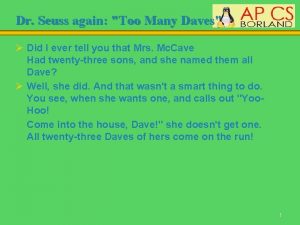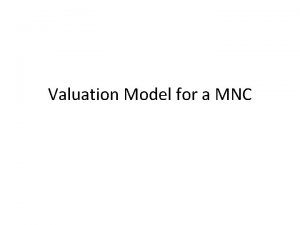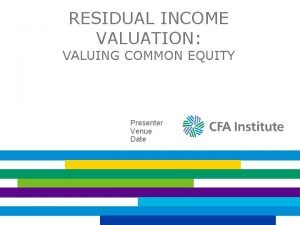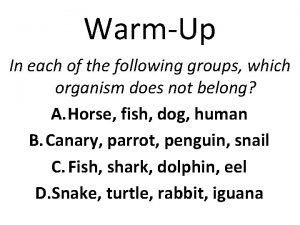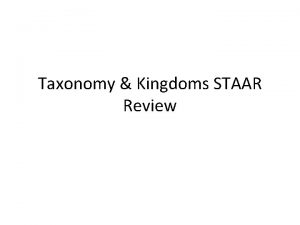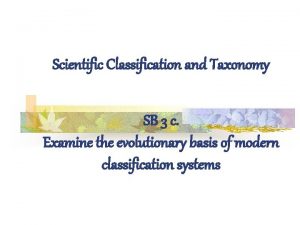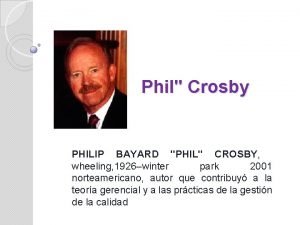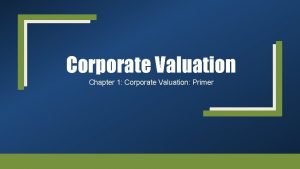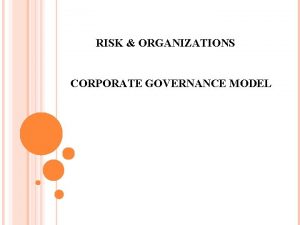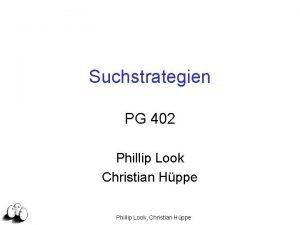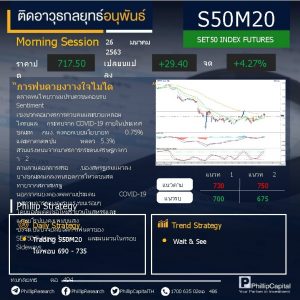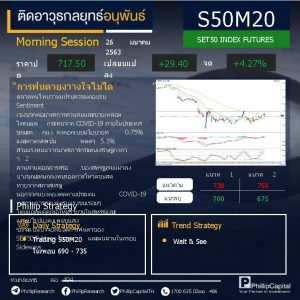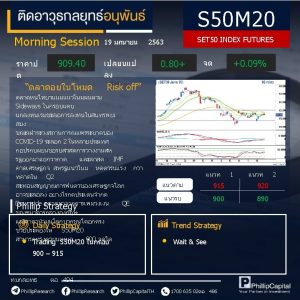Valuation Corporate Valuation Model Example 2018 Phillip Daves















- Slides: 15

Valuation Corporate Valuation Model Example © 2018 Phillip Daves

BIG Picture Total Value V Operations Total Value Equity V Non Operating Assets 2 Debt

Steps to calculate intrinsic value of equity 1. 2. 3. 4. Estimate WACC Project financial statements Calculate projected FCFs Discount at WACC to get value of Ops (including horizon value) 5. Add non-operating assets 6. Subtract debt

Step 1 (estimate WACC) and Step 2 (project financial statements) Require skills, training, and judgment. We will work through examples of increasing complexity to develop and then hone our valuation skills. Dealing with real companies is always problematic! Their data is incomplete. Estimates are guesses. Historical data may be missing. Comparables might not exist. But you have to value them anyway! To be effective, you have to know what you are doing. Know why you are doing it. Know how to make estimates for things you don’t know. Know the limitations of your data and your analysis.

First, simplest example Forecasted FCFs over next 5 years $1, 000 s: Year 1 2 3 4 5. . . FCF 25 27 30 31 34 • long-term growth rate = 6% • WACC = 10% • Right now, all debt = $200, 000 $25, 000 in non-operating assets • Calculate the intrinsic value of the equity

Horizon value • Since the firm will, presumably, exist a long time, you need a horizon value. That is, the PV of all cash flows after Year 5 back to Year 5. Use the constant growth model: • HV 5 = FCF 5(1+g)/(WACC – g) = 34(1. 06)/(0. 10 – 0. 06) = 901 Hint: not familiar with this? Look at your Principles of Finance notes on the dividend growth model!

PV of HV and FCFs Now your time line is Year 1 2 3 4 5 FCF 25 27 30 31 34 HV 901 Using the NPV function in Excel you get the PV of these to be $669. 32.

BIG Picture Total Value $25, 000 $200, 000 $669, 320 V Operations V Non Operating Assets Total value = $25, 000 + $669, 320 = $694, 320 Equity Debt Equity = $694, 320 - $200, 000 = $494, 320 8

In Excel

In Excel

In Excel

In Excel

In Excel

In Excel

So there you have it. The Corporate Valuation Model in a nutshell. All of the rest of valuation is just filling in the details: • WACC Calculation • Financial statements projections • FCF calculation • Growth rate estimates
 Corporate valuation model
Corporate valuation model Dr seuss too many daves
Dr seuss too many daves Too many daves poem
Too many daves poem Fixed income valuation methods
Fixed income valuation methods Que letra continua m v t m j
Que letra continua m v t m j Objectives of corporate finance
Objectives of corporate finance Valuation model for an mnc example
Valuation model for an mnc example Valuation model for an mnc example
Valuation model for an mnc example Residual income valuation model example
Residual income valuation model example King phillip came over for good soup
King phillip came over for good soup King phillip came over for good soup
King phillip came over for good soup Dear king phillip came over
Dear king phillip came over Kingdom chart
Kingdom chart King phillip came over for good soup
King phillip came over for good soup King philip kingdom phylum
King philip kingdom phylum Phillip crosby
Phillip crosby

